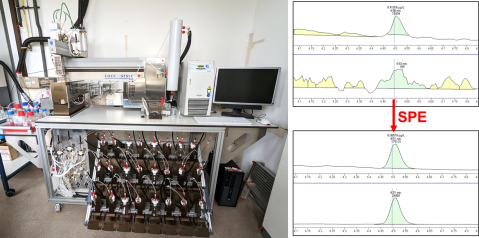BWB: How to find the least concentrated PFAS
One focus of the PROMISCES project is to analyze industrial trace substances in different water matrices. The word “trace substance” already suggests that we are dealing with very low concentrations. Per- and Polyfluorinated alkyl substances (PFAS) belong to a group of compounds that are of interest for the project.
These substances are currently the subject of scientific and political debate. Regulated limit values are getting lower and lower, therefore laboratories need highly sophisticated detection methods. The analysis of this group of substances poses challenges for laboratories in terms of sampling and sample treatment as well as analytical equipment and possible contaminations. To reach the lower nanogram-per-liter range (10 9 g/L), sample handling needs to be highly precise and clean. State-of-the-art liquid chromatography systems are just on the edge to meet current and upcoming legislative requirements for the limits of quantification. In order to close this gap, Berliner Wasserbetriebe (BWB) is developing a method that on the one hand minimizes the influence of matrix effects and, on the other hand, concentrates the analytes in a sample.
Matrix effects have a major influence on the measurement background and therefore also on the sensitivity of the measuring device. Via a so-called solid phase extraction (SPE), these two factors will be improved. SPE is an extraction technique that purifies and isolates dissolved compounds in water according to their physical properties. In addition to a direct injection method for PFAS analysis using liquid chromatography with a tandem mass spectrometer (LC-MS/MS), the extension of the sample preparation using SPE is currently under development at Berliner Wasserbetriebe as part of PROMISCES. Through an automatic SPE device that can handle multiple samples at once, this preparation process is very effective and achieves a high sample throughput.
So far, the purification greatly improves the response of the analytes in the mass spectrometer, as shown in the picture, by reducing the background noise. The goal is to improve the limit of quantification (LOQ) of 51 PFAS from 1-3 ng/L by a factor of 100, while maintaining the robustness of the direct injection method. After validating these analytics, we will use them for monitoring tasks in groundwater, urban runoff, and surface water in the Berlin case study.

Fully automated solid phase extraction device, that can handle up to 24 1L-samples. Improvement of chromatograms of PFHxA through reduction of background noise and concentration of the analyte. @Tobias Hensel (BWB).
